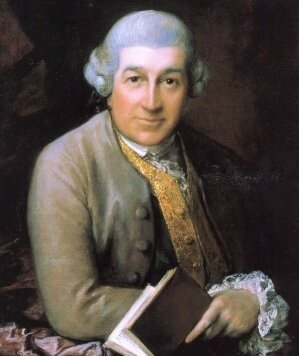Garrick's portrait
I found a short reference to Abel's painting by Gainsborough while reading the painter's obituary (02/08/1788) in a selection of articles from the Gentleman's Magazine - other posts will follow on that subject, since the GM is one major source of informations about the London social and artistic life.
The reference is not terribly elaborate, but it follows an anecdote about the famed Drury Lane actor David Garrick (1717-1779), who apparently couldn't help making faces while posing. As a consequence, the portrait didn't achieve the same level of accuracy and effectivity as that of Abel (which is highly debatable):
"[Gainsborough's] portraits are calculated to give effect at a distance; and that effect is produced in so eminent a degree, that the picture may almost be mistaken for the original; but, closely inspected, we wonder at the delusion, and find scratches that have no appearence of eye-brows, or nostrils. He told the writer of part of this article, that he never found any portrait so difficult to hit as that of Mr. Garrick; for when he was sketching the eye-brows, and thought he had hit upon the precise situation, and looked a second time at his model, he found the eye-brows lifted up to the middle of his forehead, and when he a third time looked, they were dropped like a curtain close over the eye; so flexible and universal was the countenance of this great player, that it was impossible to catch his likeness, as it is to catch the form of a passing cloud. This portrait did not do any honour to either artist or comedian."
"Very different is the full-length portrait of Mr. Abel, with the dog under the table, which combines with the force of a sketch the high-finishing of a miniature. To this may be added many others of equal merit, though not finished with equal delicacy. Indeed, finishing was not his aim; for he usually painted with a very long and very broad brush, stood very far from his canvas, and in a room with very little light. Portraits were not his forte. His fame rested on better ground, upon an almost unparalleled extent of talent in landscapes, animals, and rustic figures. In his landscapes he has at different times assumed the manner of many different artists, and while he adhered to them equalled them all; and in some of his latter pictures so far united these different styles as to form one grand whole, peculiarly his own, and peculiarly excellent."
(Selection
of Curious Articles from the Gentleman’s Magazine, in four volumes, vol.IV second edition London:Longman,Hurst, Rees, Orme and Brown,
Paternoster-Row; and Munday and Slatter, Oxford (1811)

/https%3A%2F%2Fprofilepics.canalblog.com%2Fprofilepics%2F3%2F1%2F318171.jpg)



/https%3A%2F%2Fstorage.canalblog.com%2F60%2F70%2F369818%2F25422739_o.jpg)
/https%3A%2F%2Fstorage.canalblog.com%2F89%2F01%2F369818%2F24776514_o.jpg)
/https%3A%2F%2Fassets.over-blog.com%2Ft%2Fcedistic%2Fcamera.png)
/https%3A%2F%2Fstorage.canalblog.com%2F07%2F98%2F369818%2F23323681_o.jpg)